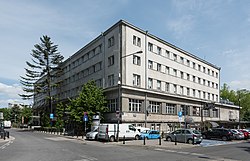
Kielce is a city in southern Poland, and the capital of the Świętokrzyskie Voivodeship. In 2021, it had 192,468 inhabitants. The city is in the middle of the Świętokrzyskie Mountains, on the banks of the Silnica River, in the northern part of the historical Polish province of Lesser Poland.
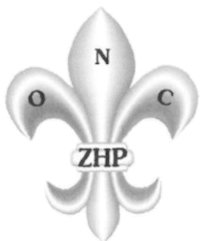
The Polish Scouting and Guiding Association is the coeducational Polish Scouting organization recognized by the World Organization of the Scout Movement and the World Association of Girl Guides and Girl Scouts. It was founded in 1918 and currently is the largest Scouting organization in Poland. The first ZHP was founded in 1916, the current one is the fourth organization with this name. It is a public benefit organization as defined by Polish law.
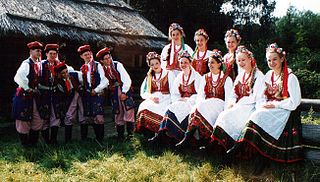
Kraków is considered by many to be the cultural capital of Poland. It was named the European Capital of Culture by the European Union for the year 2000. The city has some of the best museums in the country and several famous theaters. It became the residence of two Polish Nobel laureates in literature: Wisława Szymborska and Czesław Miłosz, while a third Nobel laureate, the Yugoslav writer Ivo Andrić also lived and studied in Krakow. It is also home to one of the world's oldest universities, the Jagiellonian University of Kraków.
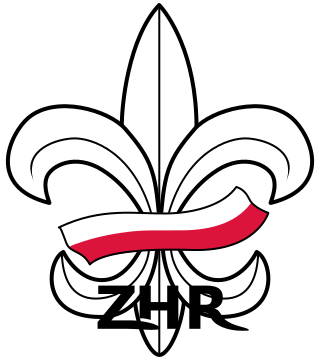
Związek Harcerstwa Rzeczypospolitej is a Polish Scouting organization founded on February 12, 1989. At present, Związek Harcerstwa Rzeczypospolitej has over 17,500 members. At present, Związek Harcerstwa Rzeczypospolitej is an associate member of the Confederation of European Scouts.
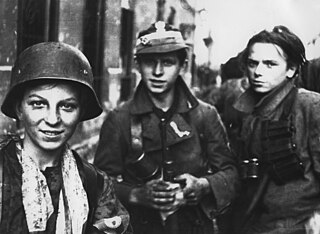
"Gray Ranks" was a codename for the underground paramilitary Polish Scouting Association during World War II.

Olga Boznańska was a Polish painter of the turn of the 20th century. She was a notable painter in Poland and Europe, and was stylistically associated with the French impressionism, though she rejected this label.

Aleksander Kamiński, assumed name: Aleksander Kędzierski. Also known under aliases such as Dąbrowski, J. Dąbrowski, Fabrykant, Faktor, Juliusz Górecki, Hubert, Kamyk, Kaźmierczak, Bambaju – a teacher, educator, professor of humanities, co-founder of Cub Scouts methodology, scout instructor, scoutmaster, soldier of the Home Army and one of the ideological leaders of the Grey Ranks, chairman of the Presidium of the Supreme Council of the Polish Scouting Association.

The National Museum in Warsaw, popularly abbreviated as MNW, is a national museum in Warsaw, one of the largest museums in Poland and the largest in the capital. It comprises a rich collection of ancient art, counting about 11,000 pieces, an extensive gallery of Polish painting since the 16th century and a collection of foreign painting including some paintings from Adolf Hitler's private collection, ceded to the museum by the American authorities in post-war Germany. The museum is also home to numismatic collections, a gallery of applied arts and a department of oriental art, with the largest collection of Chinese art in Poland, comprising some 5,000 objects.

The Scouting and Guiding movement in Poland consists of about twelve independent organizations with an overall membership of about 160,000 Scouts and Guides. The largest organization by membership is Polish Scouting and Guiding Association with about 140,000 members.

The National Museum in Kraków, popularly abbreviated as MNK, is the largest museum in Poland, and the main branch of Poland's National Museum, which has several independent branches with permanent collections around the country. Established in 1879, the Museum consists of 21 departments which are divided by art period: 11 galleries, 2 libraries, and 12 conservation workshops. It holds some 780,000 art objects, spanning from classical archeology to modern art, with special focus on Polish painting.

POLIN Museum of the History of Polish Jews is a museum on the site of the former Warsaw Ghetto. The Hebrew word Polin in the museum's English name means either "Poland" or "rest here" and relates to a legend about the arrival of the first Jews to Poland.

The National Museum in Poznań, Poland, abbreviated MNP, is a state-owned cultural institution and one of the largest museums in Poland. It houses a rich collection of Polish painting from the 16th century on, and a collection of foreign painting. The museum is also home to numismatic collections and a gallery of applied arts.
The Museum of Polish History or the Polish History Museum is a museum and national cultural institute in Warsaw, Poland. The purpose of the museum is to present the most important events in Polish history, with a particular emphasis on Polish traditions of freedom.

The Fryderyk Chopin Museum is a museum in Warsaw, Poland, established in 1954 and dedicated to Polish composer Frédéric Chopin. Since 2005, the museum has been operated by the Fryderyk Chopin Institute.
Józef Kachel was a Polish Boy Scouts Scoutmaster in Germany, a member of the Polish United Workers' Party (PZPR), and a Member of the Polish Parliament

Stefan Adam Garwatowski or Gerwatowski was a Polish painter. He was an alumnus of Academy of Fine Arts in Warsaw (1956).
Ryszard Wcisło "Chytry Jastrząb" was a Polish scout leader who worked in the Krakow branch of Polish Scouting and Guiding Association, KIHAM, ZHP-1918, and lately in Scouting Association of the Republic.

The Michniów massacre occurred on 12–13 July 1943 in the village of Michniów during German occupation of Poland when approximately 204 of its inhabitants, including women and children, were massacred by a German Ordnungspolizei, SS.

The Mausoleum of the Martyrdom of Polish Villages in Michniów is a museum located in Michniów, in Świętokrzyskie Voivodeship, in Poland, constituting a branch of the Museum of the Kielce Village, commemorating the pacification actions in German-occupied Poland.

The Leon Wyczółkowski Regional Museum is an ensemble of cultural institutions which have been first created in 1923 in the city of Bydgoszcz, Poland.
